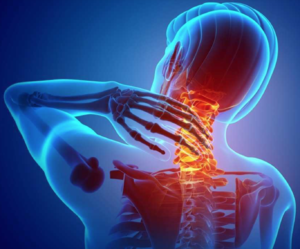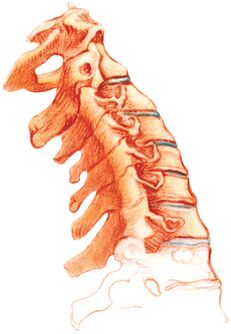Acute Neck Pain
Introduction (Add citation at the end)[edit | edit source]
Acute neck pain is characterised by its sudden onset, typically lasting less than three months. This discomfort can manifest as localised pain or radiate to the head, shoulders, and arms. According to NICE guidelines, the prevalence of condition-specific acute neck pain ranges from 40 to 70%. Various factors such as injury, disease, wear and tear, or poor biomechanics can stress the spine and lead to this type of pain. However, pinpointing the exact source of discomfort can be challenging. Potential contributing factors may include nerve damage, tissue scarring, arthritis, and the emotional effects of pain.
Functional Anatomy[edit | edit source]
The cervical spine consists of several structural group:
- Muscles - anterior muscles, posterior muscles, lateral muscles, muscles that feed into the neck
- Ligaments - anterior and posterior longitudinal ligament, intertransverse ligaments, nucheal ligament, alar ligaments, apical ligaments of dens, yellow ligaments
- Neurological structures - arteries, nerves, glands, and 2 passageways
These three structural groups in the cervical spine works together to serve the three main functions of the cervical spine:
- Protect spinal cord
- Support the head and allow movements
- Provide a safe passageway for vertebral arteries
Mechanism of injury and differential diagnosis[edit | edit source]
Understanding the mechanism of acute neck pain and differential diagnosis are the key parts of a physiotherapy assessment process. Various sources can contribute to acute neck pain:
- Cervical muscle sprain - Most common cause of acute neck pain, usually caused my overuse of the musculature e.g., sitting hunched over in a chair
- Muscle weakness - Training muscles asymmetrically can cause pain i.e., training upper traps more than lower traps can lead to overstimulation of the upper traps, the difference can cause pain
- Concussion - After a concussion, people may experience head and neck pain, it can start quickly after and last anywhere from a few days to months/years. Any symptoms that last longer than 3 months after is considered post-concussion syndrome
- RTA - Symptoms can occur suddenly or within a few days following an accident , similar to a concussion, how long the symptoms last can range
- Whiplash- This can occur within a RTA or from another type of trauma e.g., a fall
Classification[edit | edit source]
According to the updated neck pain revision of the Orthopaedic Section of the American Physical Therapy Association (APTA) in 2017, these are the revised clinical guidelines for neck pain classification:
- Neck pain with mobility deficits
- Neck pain with movement coordination impairments
- Neck pain with headaches
- Neck pain with radiating pain
Risk factors[edit | edit source]
Identifying and understanding risk factors is crucial for prevention and early diagnosis, as acute neck pain can potentially evolve into chronic conditions. Potential contributing risk factors include:
- Advanced age[1]
- Female[2]
- History of neck, shoulder, and pelvis trauma[3][2]
- Psychological factors[4]
- Lifestyle[4]
- ↑ Jeanmonod, R. and Varacallo, M. (2018). Geriatric Cervical Spine Injury. [online] Nih.gov. Available at: https://www.ncbi.nlm.nih.gov/books/NBK470375/.
- ↑ 2.0 2.1 Safiri, S., Kolahi, A.-A., Hoy, D., Buchbinder, R., Mansournia, M.A., Bettampadi, D., Ashrafi-Asgarabad, A., Almasi-Hashiani, A., Smith, E., Sepidarkish, M., Cross, M., Qorbani, M., Moradi-Lakeh, M., Woolf, A.D., March, L., Collins, G. and Ferreira, M.L. (2020). Global, regional, and national burden of neck pain in the general population, 1990-2017: systematic analysis of the Global Burden of Disease Study 2017. BMJ, p.m791. doi:https://doi.org/10.1136/bmj.m791.
- ↑ Clayton, J.L., Harris, M.B., Weintraub, S.L., Marr, A.B., Timmer, J., Stuke, L.E., McSwain, N.E., Duchesne, J.C. and Hunt, J.P. (2012). Risk factors for cervical spine injury. Injury, [online] 43(4), pp.431–435. doi:https://doi.org/10.1016/j.injury.2011.06.022.
- ↑ 4.0 4.1 Kazeminasab, S., Nejadghaderi, S.A., Amiri, P., Pourfathi, H., Araj-Khodaei, M., Sullman, M.J.M., Kolahi, A.-A. and Safiri, S. (2022). Neck pain: global epidemiology, trends and risk factors. BMC Musculoskeletal Disorders, [online] 23(1). doi:https://doi.org/10.1186/s12891-021-04957-4.








